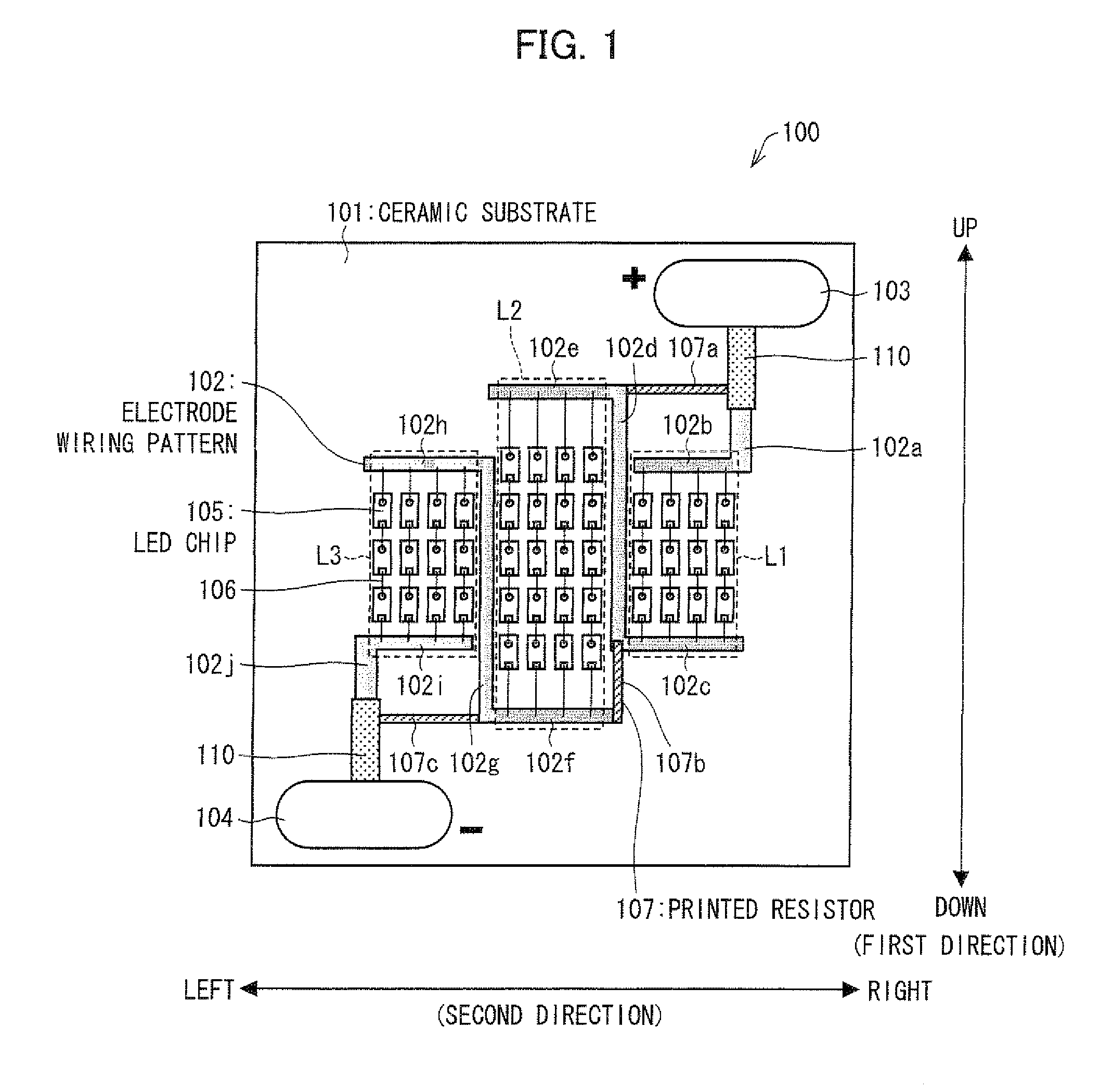Light emitting device
- Summary
- Abstract
- Description
- Claims
- Application Information
AI Technical Summary
Benefits of technology
Problems solved by technology
Method used
Image
Examples
embodiment 1
[0044]The following describes one embodiment of the present invention with reference to drawings. Initially explained is an entire configuration of a light emitting device, briefly. Then, characteristic configurations, a production method, and the like of the light emitting device will be explained in order.
[0045](Entire Configuration)
[0046]FIG. 1 is a top view illustrating one exemplary configuration of a light emitting device 100 according to the present embodiment. More specifically, FIG. 1 illustrates the light emitting device 100 in which LED chips 105 and the like are provided on a primary surface of a ceramic substrate 101 but they have not been resin-molded yet. FIG. 2 is a top view illustrating one exemplary configuration of the light emitting device 100 of the present embodiment. More specifically, FIG. 2 illustrates the light emitting device 100 as a finished package in which the LED chips 105 and the like provided on the primary surface of the ceramic substrate 101 are r...
modified example
[0121]The aforementioned light emitting device 100 uses a ceramic substrate 101, but is not limited to this. The light emitting device 100 may use other substrates instead. For example, a metal core substrate including a metal substrate on whose surface an insulating layer is provided may be used. In this case, the insulating layer is formed only in an area where the printed resistors 107 and the electrode wiring pattern 102 are to be formed, so that a plurality of LED chips 105 are directly provided on the metal substrate surface.
[0122]Further, the outer shape of the ceramic substrate 101 is not limited to a rectangular shape. Further, the vertical direction (up-and-down direction / first direction) and the horizontal direction (left-to-right direction / second direction) on the primary surface is not determined based on the outer shape of the primary surface, but is determined depending on relative positional relationship of the electrode wiring pattern 102, the LED chips 105, and the...
embodiment 2
[0127]FIG. 5 is a top view illustrating one exemplary configuration of a light emitting device 200 of the present embodiment.
[0128]The light emitting device 200 of the present embodiment is different from the light emitting device 100 of Embodiment 1 in terms of how the electric circuit is configured. Except for this point, the light emitting device 200 has a configuration equivalent of the light emitting device 100 of Embodiment 1.
[0129]As illustrated in FIG. 5, the light emitting device 200 has a circuit configuration in which 14 series circuit sections, in each of which 7 LED chips 105 are linearly aligned so as to be connected in series, are connected in parallel. In other words, 98 LED chips 105 in total, which are connected in a series-parallel connection (i.e., 7-series-connected LED chips per series circuit section×14 parallel-connected series circuit sections), are provided on a primary surface of a ceramic substrate 101.
[0130]The electrode wiring pattern 102 is constituted...
PUM
 Login to View More
Login to View More Abstract
Description
Claims
Application Information
 Login to View More
Login to View More - R&D
- Intellectual Property
- Life Sciences
- Materials
- Tech Scout
- Unparalleled Data Quality
- Higher Quality Content
- 60% Fewer Hallucinations
Browse by: Latest US Patents, China's latest patents, Technical Efficacy Thesaurus, Application Domain, Technology Topic, Popular Technical Reports.
© 2025 PatSnap. All rights reserved.Legal|Privacy policy|Modern Slavery Act Transparency Statement|Sitemap|About US| Contact US: help@patsnap.com



